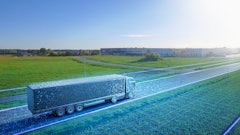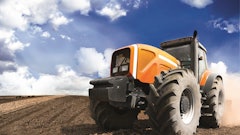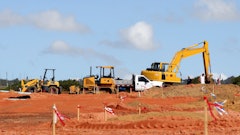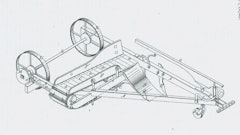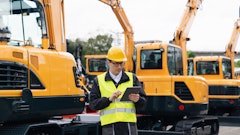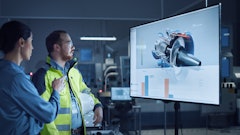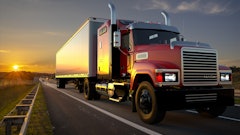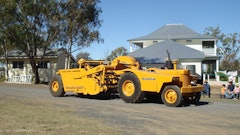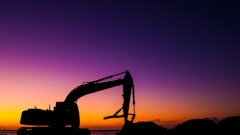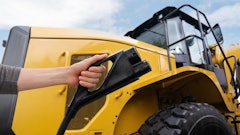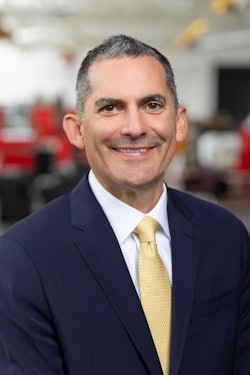
Executive Director of Off-Highway Business Cummins
To assess emerging trends and the current and future OEM landscape, the OEM Off-Highway team team spoke with experts throughout the industry. In our conversation below, Beau Linteruer, executive director of off-highway business at Cummins, offers insights into today's challenges and tomorrow's opportunities.
Lintereur, who has extensive Cummins experience, was named to his current position in August 2023. Prior to the move, he headed up the Mining and Aftermarket businesses for Power Systems at Cummins. He joined Cummins in 1998 and has held roles in the Power Electronics, global transfer switch, Power Generation, Filtration, and the Power System businesses, including overseas assignments in China and India. Lintereur holds a bachelor's degree in aeronautical and astronautical engineering from Purdue University, a master's degree in the same field from MIT and a master's degree in management and a certificate in public management policy from Stanford University.
Read on for Linteruer's insights into the state of the industry.
1. What challenges most affected the mobile OEM landscape in 2023?
Supply chain challenges have continued to have a major impact on our industry over the last few years into 2023. We have seen some level of easing in this recently, however managing inventory and continuing to meet customer deadlines remains a challenge across our markets.
2. What are your predictions for the mobile OEM landscape in 2024?
The COVID-19 pandemic has impacted the industry in a number of ways that we see as ongoing trends. The number of products moving through the rental channel continues to increase, as contractors look to minimize risk and reduce capital expenditure. They can bring in specialist equipment as is needed and return it once their project is complete providing more control of costs. Other cost savings and efficiency improvements are being achieved through the adoption of technologies such as telematics which helps maximize uptime and equipment usage as well as improve service response capability and time. Cummins Connected Diagnostics systems are available with several key telematic service providers such as Trimble, Topcon, TeliQ, Saucon, Elevat and others.
3. Where do you see the most potential for improvement or advancement in 2024?
For Cummins, we have a dual strategy around sustainability and carbon reductions:
- Continuing to advance engine technology with further advancements in performance, efficiency and compatibility with cleaner fuels
- Innovating zero-emissions solutions like hydrogen fuel cell and battery technology that can get us to zero emissions
In the short term, it means ensuring our current problems deliver for customers today and in the near term, and allow us to invest in the future technology to be ready for when they are ready to adopt it. There is a lot of focus on our next-generation engine platforms as part of our path to zero.
4. What will be the biggest challenge for OEMs and the industry in general in 2024?
Aside from continued management of supply chain challenges, navigating a complex and uncertain market landscape will be focal. We are experiencing a period of emissions stagnation in traditional lead emission markets, coupled with mixed signals regarding zero emissions implementation. OEMs will strive for competitiveness in the market and be required to place their bets on where to allocate engineering resources. Internal combustion engines (ICE) will continue to be the prime mover in off highway markets for the foreseeable future. Selecting the right partner who will continue to serve OEMs with ICE solutions and also having an eye to the future will be a major decision ahead for customers. Cummins is well positioned to support OEMs no matter where they are in the world, or where they are in their decarbonization journey.
5. What factors should engineers and their companies consider when making decisions in the mobile OEM space in 2024?
While there is a lot of discussion about the future of power in the industry, contactors can make environmental improvements from today’s products. Construction contractors can make substantial improvements by switching their fleet to Cummins latest Performance Series engines. The high power and torque capabilities mean that they can be used to replace engines of higher displacement, improving efficiency, and reducing overall running costs without impacting productivity. Less fuel, less servicing with lower emissions with more reliability and more capability. Operators of these engines can adopt Hydrotreated Vegetable Oil (HVO100) as a drop-in substitute for traditional diesel fuel. HVO delivers up to a 90% reduction in greenhouse gas emissions compared to diesel "from well-to-wheel." Sulfur-free and oxygen-free, it does not require any engine modifications for it to be utilized. Also, many machines idle for fairly long periods during their working day. Idle shut-off or stop-start capabilities can be deployed to reduce idle time, which cuts emissions, onsite noise, and fuel consumption. When used on our B6.7 Performance Series engine, we’ve seen fuel savings of at least 10%.
6. Please highlight a recently introduced product from your company that meets a specific, pressing need in the mobile OEM space. How is this product designed to meet that need?
At CONEXPO-CON/AGG 2023, we featured our 15-liter agnostic engine platform. This is a single platform, with a shared base engine design that can accommodate a range of low-to-zero fuels. These fuels include diesel, natural gas, low-carbon biodiesel/HVO and hydrogen — which becomes a zero-carbon fuel when produced using renewable energy sources. We see this as a route for OEMs and end users to embark on a faster and more cost-effective journey toward decarbonization. It is a technology that is proven and trusted in the industry, fits in the same place as current engines, and can be supported through today’s service channels with minimal changes.
7. What are some of your company's priorities in 2024 with regard to today's emerging trends?
As an industry we are rising to challenge to reduce our carbon emissions. The complexity and variation of applications means it is unclear what is going to be the winning solution moving forward. In fact, it looks like no single solution or path to zero will work for all of the customer machines we power. This the reason Cummins is growing its portfolio of solutions, building knowledge, capability, and scale across a range of technologies that will support customers whichever path they take. The breadth of our business across market segments and regions means that we are the ideal partner to help our customers through this transition.
For additional insights on the state of the industry and what's to come in 2024, click here to read more.





